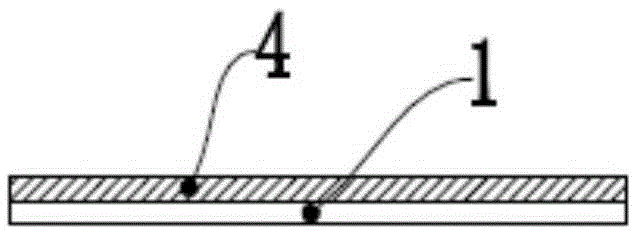A brick adobe fired into a glass-ceramic composite board at one time
A technology of glass-ceramic and glass-ceramic frit, which is applied in the field of architectural ceramics, can solve the problems of low yield, low flatness, affecting the quality and aesthetics of glass-ceramic composite panels, and achieves high yield, Color effects have no effect
- Summary
- Abstract
- Description
- Claims
- Application Information
AI Technical Summary
Problems solved by technology
Method used
Image
Examples
Embodiment 1
[0031] Components of each 100kg of glass-ceramic frit particle fixative: 5.5kg of hydroxyethyl cellulose (purchased by Guangzhou Moke Building Materials Technology Co., Ltd.), 2.5kg of white carbon black, 1.1kg of polymethylsiloxane, silicone modified Sodium phosphate 1.7kg, the balance is ethylene glycol.
[0032] The preparation method of the above-mentioned frit particle binder comprises the following steps: a) dissolving hydroxyethyl cellulose in ethylene glycol and stirring evenly; b) adding polymethylsiloxane and organosilicon-modified sodium phosphate, Stir evenly; c) Add white carbon black and the remaining ethylene glycol solvent, stir evenly to obtain a frit particle binder, and measure its flow rate to be 26.8s (30°C, coat -4 cups). It should be noted that the organosilicon-modified sodium phosphate can be replaced by sodium polyacrylate or sodium hexametaphosphate as a dispersant, and this solution can also be realized.
Embodiment 1-1
[0034] A method for preparing a once-fired transparent glass-ceramic composite board, comprising the following steps:
[0035] A. Green body stamping and forming: After the green body powder (fineness is 150 degrees) and micropowder powder (fineness is 150 degrees) are layered, punched into a green body with a bottom blank layer and a micropowder layer, wherein the micropowder layer The thickness is 1 / 2 of the bottom base layer thickness, dry;
[0036] B. Spray a layer of water-repellent layer 2: Spray a layer of silicone water-repellent on the surface of the green body;
[0037] C, applying glass-ceramic frit particle suspension: the glass-ceramic frit particle of 375kg silver-white ice crystal effect (purchasing from Quincy Carloby glaze company, fineness 100 orders) is added 125kg that embodiment 1 makes In the frit particle binder, mix evenly to get glass-ceramic frit particle suspension, the solid content of glass-ceramic frit particles is 75%, no visible bubbles, and th...
Embodiment 1-2
[0042] A method for preparing a once-fired transparent glass-ceramic composite board, comprising the following steps:
[0043] A. Green body stamping and forming: After the green body powder (fineness is 150 degrees) and micropowder powder (fineness is 150 degrees) are layered, punched into a green body with a bottom blank layer and a micropowder layer, wherein the micropowder layer The thickness is 1 / 2 of the bottom base layer thickness, dry;
[0044] B, applying glass-ceramic frit: the glass-ceramic frit particle of 375kg silver-white ice crystal effect (purchasing from Quincy Carroby Glaze Company, fineness 100 orders) is added the frit of 125kg that embodiment 1 makes In the granular binder, mix evenly to obtain a suspension of glass-ceramic frit particles. The solid content of glass-ceramic frit particles is 84%, no visible bubbles, and the flow rate is 42.5s (30°C, coated with -4 cups). There is still no delamination phenomenon after being placed for 5 days, which shows...
PUM
| Property | Measurement | Unit |
|---|---|---|
| thickness | aaaaa | aaaaa |
| particle size | aaaaa | aaaaa |
Abstract
Description
Claims
Application Information
 Login to View More
Login to View More - R&D
- Intellectual Property
- Life Sciences
- Materials
- Tech Scout
- Unparalleled Data Quality
- Higher Quality Content
- 60% Fewer Hallucinations
Browse by: Latest US Patents, China's latest patents, Technical Efficacy Thesaurus, Application Domain, Technology Topic, Popular Technical Reports.
© 2025 PatSnap. All rights reserved.Legal|Privacy policy|Modern Slavery Act Transparency Statement|Sitemap|About US| Contact US: help@patsnap.com


